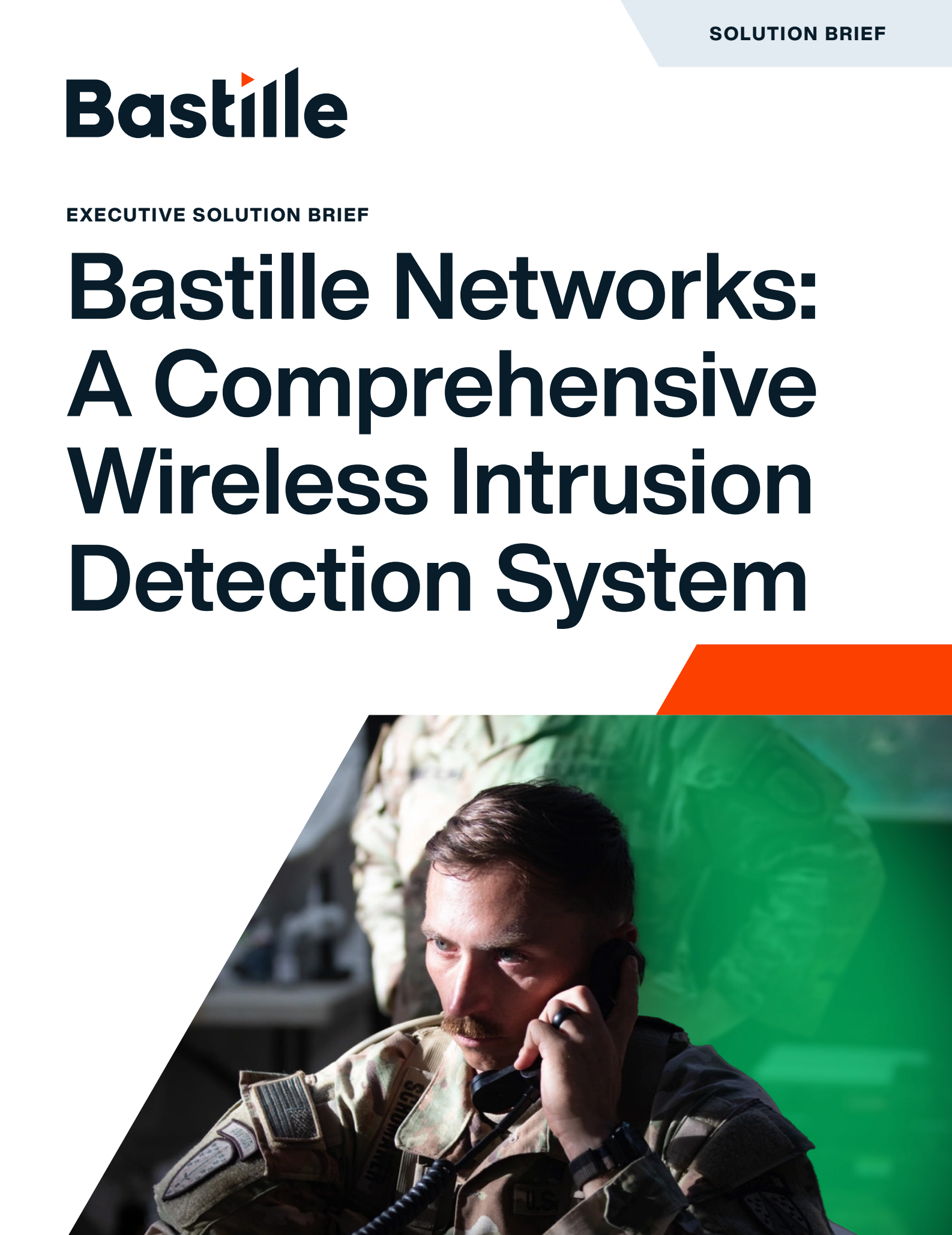In-place monitoring systems (IPMS) are designed to protect government and high-risk areas from wireless threats. In today’s cybersecurity landscape, they function best as part of a larger solution set that can detect more clandestine or low-energy devices often used for wireless espionage and data exfiltration.
What is an in-place monitoring system (IPMS)?
An in-place monitoring system (IPMS) is a security solution that continuously monitors and analyzes radio frequency (RF) activities within a designated area. IPMS is an important part of wireless airspace defense, helping detect unauthorized wireless devices and networks, malicious tools, and other wireless risks in government and commercial spaces.
The limitations of traditional IPMS
IPMS is a complementary function to wireless intrusion detection, as it typically detects RF signals on a broader spectrum with more focus on the physical environment. However, most IPMS solutions are limited in their ability to monitor complex indoor spaces with physical barriers. They also have trouble pinpointing the exact location and nature of detected devices and networks. For this reason, standalone IPMS systems are not sufficient in securing highly regulated, critical environments.
THEY’RE LIMITED IN COVERAGE, ESPECIALLY INDOORS WITH MANY PHYSICAL BARRIERS
IPMS systems alone lack the advanced scanning and AI modeling capabilities that allow platforms like Bastille to overcome the physical barriers of indoor spaces. They are better at detecting potential threats than discovering a comprehensive list of questionable devices and wireless emitters or and continuously tracking their locations.
THEY HAVE TROUBLE WITH NOISE AND FALSE POSITIVES
In environments with a high density of wireless devices, like busy offices and event spaces, IPMS can struggle to distinguish between legitimate signals and potential threats. This results in false positives, where benign devices are flagged as unauthorized or suspicious, overwhelming security teams with alerts.
THEY DETECT PRESENCE, NOT CONTEXT LIKE INTENT OR BEHAVIOR OF A DEVICE
While IPMS can detect the presence of wireless signals, it may not always be able to determine the intent or behavior of the detected device. This makes it difficult to assess whether a detected signal is a genuine threat, such as a rogue access point, or a non-malicious device operating outside standard parameters.
IPMS solutions may also have difficulty differentiating between similar types of devices, especially in environments with a mix of authorized and unauthorized devices. This can complicate efforts to pinpoint specific threats.
THEY REQUIRE SPECIALIZED EMPLOYEES TO ANALYZE THEIR DATA
IPMS generates large volumes of data about wireless activities, and making sense of this data requires specialized knowledge. Organizations often need skilled, hard-to-hire staff to interpret IPMS alerts and assess the nature of potential threats, which can increase operational costs and cause threat visibility gaps.
What does a modern in-place monitoring system (IPMS) do?
Today, the best in-place monitoring systems (IPMS) are part of a broader wireless airspace defense platform. Bastille is the only platform that offers IPMS, wireless intrusion detection, and highly accurate wireless device and network location for a complete picture of what’s happening in your facilities.
MAP AND WORK AROUND COMPLEX INTERIOR SPACES
Bastille’s patented RF tomography and sensing technology breaks through the limits of standalone IPMS systems, accurately mapping rooms and facilities without needing a blueprint and locating wireless signals despite physical barriers.
UNDERSTAND THE EXACT LOCATION, NATURE, AND DETAILS OF EACH WIRELESS ASSET DETECTED
Bastille enriches basic wireless threat detection data with business context and location data that helps security prevention and response teams better protect their facilities. The platform also allows you to play back historical locations and other forensic data for a complete view into threats once an investigation is underway.
INTEGRATE SEAMLESSLY INTO YOUR GREATER CYBERSECURITY ECOSYSTEM
Effectively using IPMS alongside other security solutions—like WIDS, SIEM, or SOAR—is critical to protect against today’s wireless threats. However, this requires expertise in integrating these tools. Bastille removes this hurdle with API-forward architecture and a collection of partner apps and integrations.
Modernizing IPMS Capabilities for Government and High-Security Environments
The traditional approach to In-Place Monitoring Systems (IPMS) has long been a cornerstone of safeguarding Sensitive Compartmented Information Facilities (SCIFs) and other classified spaces. However, these legacy systems often provide limited visibility, alerting teams to an unauthorized device within a broad area but offering no granular location data. As a result, they require personnel to perform manual physical sweeps using specialized equipment, which delays response and disrupts operations.
Bastille Delivers Precision Where Legacy IPMS Stops
Bastille’s Wireless Airspace Defense transforms the value proposition of IPMS by eliminating the limitations of zone-level detection. While conventional systems may indicate that a device is active somewhere on a floor or within a secure wing, Bastille localizes the source of transmissions in real time, down to the specific room, workstation, or equipment bay. This location-aware capability enables rapid, targeted response without relying on resource-intensive sweeps or field-deployed personnel.
In addition to accelerating incident resolution, Bastille also logs historical movement and activity of wireless devices. Security teams gain insight into how long a device was present, where it traveled within the facility, and whether it crossed into higher-security zones. This forensic visibility supports internal investigations and enhances compliance with NIST, ICD-705, and related regulatory frameworks.
More Coverage at a Fraction of the Cost
Bastille’s data-driven approach reduces total cost of ownership due to its ease of use, scalable deployment, and centralized management, while delivering continuous wireless monitoring across the RF spectrum. The platform deploys sensors and patented analytics technologies that:
- Provide coverage across Wi-Fi, LTE, 5G, Bluetooth, BLE, and other RF protocols
- Localize the source of transmissions to within one to three meters in real time
- Detect and alert on unauthorized wireless emitters, including cell phones, wearables, and rogue IoT devices
- Deliver uninterrupted 24/7/365 monitoring with 100% passive infrastructure
- Does not require operators to be RF experts
- Does not require manual intervention to locate devices
By delivering comprehensive, real-time RF situational awareness, Bastille dramatically reduces both CapEx and OpEx compared to legacy IPMS deployments, without compromising coverage or accuracy.
Real-Time Wireless Situational Awareness
Bastille continuously monitors the wireless airspace and instantly flags unauthorized transmissions, giving security teams the visibility and context needed to respond effectively. With Bastille, organizations gain:
- Live dashboards that visualize all wireless activity in and around secure spaces
- Automated alerts on policy violations or anomalous signals
- Forensic analysis capabilities, including historical RF replay and signal pattern tracking
This functionality enables facilities to transition from periodic manual checks to continuous RF surveillance, thereby enhancing compliance readiness and improving threat response times.
Designed for Classified and Controlled Spaces
Bastille’s solution is purpose-built for deployment in:
- SCIFs and secure conference rooms
- DoD and Intelligence Community (IC) facilities
- Government contractor sites and classified workspaces
- Embassies and forward operating locations
Because the system is passive, adversaries cannot detect it, and it does not interfere with authorized RF systems, making it ideal for high-security environments.
Centralized Management for Distributed Environments
Bastille’s centralized console simplifies policy enforcement and monitoring across multi-site deployments, whether nationwide or globally distributed. With remote access controls, role-based user permissions, and detailed audit logging, Bastille supports compliance with NIST, ICD 705, and agency-specific directives.
FAQs About In-Place Monitoring Systems (IPMS)
What is an In-Place Monitoring System (IPMS)?
An IPMS is a security system that continuously monitors radio frequency (RF) activity in a specific area to detect unauthorized wireless devices, rogue access points, or malicious wireless behavior. It’s commonly used in government and high-security spaces as part of a larger wireless threat detection strategy.
What are the limitations of traditional IPMS systems?
Traditional IPMS tools often struggle with signal interference, false positives, and limited visibility in complex indoor environments with walls and barriers. They detect the presence of signals but lack the context or pinpoint accuracy to identify threats in real time. They also require skilled staff to interpret the data, which can slow response times.
What is an example of an In-Place Monitoring System (IPMS)?
Bastille is a leading example of a modern IPMS. It passively scans the full radio frequency spectrum within secure facilities to detect, locate, and analyze wireless devices, even low-energy or clandestine ones. Unlike traditional systems, Bastille combines RF sensing, device behavior analysis, and integration with broader security tools to deliver full situational awareness.
How is Bastille’s IPMS different from standard systems?
Bastille goes beyond basic RF detection by using patented RF tomography to accurately map indoor environments and track devices within 1–3 meters. It provides enriched data with context, real-time location, and historical playback to support investigation and response, making it far more actionable than traditional IPMS.
Can IPMS detect intent or behavior, or just presence?
Most IPMS systems only detect that a signal is present. Bastille’s platform adds behavioral context, helping distinguish between a harmless personal device and a potentially malicious rogue device. This reduces false positives and helps security teams focus on real threats
How do I integrate IPMS into an existing security stack?
With Bastille, integration is simple. The platform offers open APIs and native connections to tools like Splunk, SIEM, and SOAR systems, allowing IPMS data to work seamlessly alongside your broader cybersecurity infrastructure without requiring custom development.
How does Bastille compare to traditional IPMS in terms of cost and expertise required?
Traditional IPMS solutions may appear more affordable at first but often require dedicated analysts to interpret RF data, leading to higher operational costs over time. Bastille streamlines this by providing enriched, actionable data with built-in context and intuitive visualizations. It’s designed to be used by existing security teams without the need for deep RF expertise, making it a more efficient and scalable solution for complex environments.
What types of environments benefit most from using IPMS?
IPMS is especially useful in secure facilities like government buildings, defense spaces, and critical infrastructure environments. These areas require constant wireless monitoring to detect unauthorized devices, minimize the risk of data exfiltration, and confirm compliance with strict wireless security standards policies.
IPMS works best when integrated with systems like WIDS, SIEM, or SOAR. While IPMS can detect RF activity, combining it with other tools provides more context, automation, and threat response capabilities. Bastille supports this function with API integrations and a platform designed for seamless ecosystem compatibility. Additionally, Bastille provides location capabilities without the need for manual sweeps.
Learn More or Request a Demo
Bastille is redefining the economics and effectiveness of In-Place Monitoring Systems. Government and classified organizations can now achieve comprehensive RF situational awareness and wireless threat detection, with real-time precision, at a fraction of the cost of legacy systems.
Request a Demo or Contact Us to learn how Bastille can modernize IPMS operations.


